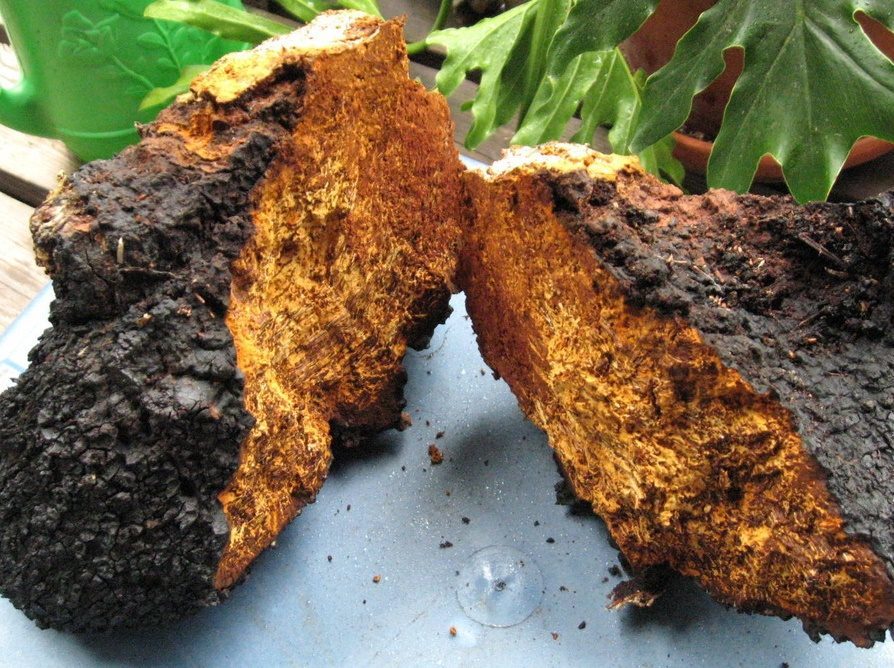Chaga Mushroom (link to our one!) is actually quite difficult to find within Australia at times, along with finding it for a reasonable price! As one of the most expensive herbal teas around, what makes it so good and why are people willing to pay for this prized mushroom?
Let us take a look.
About the Chaga Mushroom
Chaga (Inonotus obliquus) is a type of fungus from within the Hymenochaetaceae family and has the unusual and unassuming appearance of burnt charcoal. Basically it looks like a big black mass growing out of a tree and doesn't look all that appetizing! A hard black crust surrounds the mushroom, which when removed from the tree harms neither the mushroom nor the tree.
Normally these mushrooms will appear on trees that are over 40 years old, and the mushroom itself is ready to be harvested after growing around 5 years. (This may partly explain the price somewhat)
Amazingly, the mushroom can grow to be up to 1.5 meters and weigh 20kg or more!
Benefits of Chaga Mushrooms
For centuries, people have been using Siberian Chaga and its variations within other countries for a variety of medicinal uses. Our descendants somehow (I never know how they find these things out) knew that this mushroom had great health benefits - but today modern science has unlocked the secrets of this mushroom to give a more accurate understanding of exactly what's going on.
https://www.ncbi.nlm.nih.gov/pmc/articles/PMC4946216/
We try to stay away from tumor and cancer claims here, but tests done on mice were rather promising, however further studies, of course, need to be done.
'Anticancer activity of the I. obliquus extract was examined in mouse models of Lewis lung carcinoma growth and spontaneous metastasis after 3 weeks of continuous extract intake at the dose of 6 mg/kg/day, which corresponded to that ingested daily with Chaga infusion in Japan. The extract of I. obliquus caused significant tumor-suppressive effects in both models.'
For a much wider research database on the Chaga Mushroom, please follow this link.
These days, Chaga is being used for a variety of unique uses
- Promote improved energy levels and stamina
- Support the immune system
- Promote alleviation of stress
- Get the benefits of a powerful adaptogen
- Help stimulate mental alertness when experiencing fatigue
- Stimulate body detoxification and improved digestion
- Promotes a healthy appearance of skin and hair
The Structure of the Chaga Mushroom
Within the black crusty exterior, is the 'fruit' of the mushroom e.g the useful part.
Interestingly, the first and second layers contain 80% of the useful compounds within the mushroom - and the 3rd layer providing almost no benefit at all due to being void of useful substance.
Note: Our Chaga tea is comprised of only the first and second layers and is therefore of high quality. More on this below!

Natural Wild Chaga vs Artificial Chaga
Now, this is the part I personally find the most interesting.
The Chaga Mushroom thrives in the cold, grows on birch and beech trees - along with alder, chestnut, and hornbeam trees. Why is this important? Only Chaga Mushroom grown on Birch trees have healing properties! More so than most other teas, the origin and growth method of the Chaga Mushroom is critically important.
Chaga Mushrooms do not gain growth via the sun - they do so from the tree itself and thus - what the tree provides to the mushroom will determine the medicinal properties such as substances like chromogens (polyphenol pigments), polyphenols, hydroxyphenyl carboxylic acids, and quinones.
When Chaga is grown artificially and by different methods, all healing properties are lost as it's simply not possible for the Chaga to then contain what it needs to be effective. Artificial Chaga also only contains 1 layer, rather than the 3 mentioned above.
Optimum Requirements for Chaga Mushrooms To Grow
Essentially, all of these requirements must be met for Chaga to be producing the highest benefits it possibly can. This list has been sourced from our origin supplier here.
- It grew on a wild birch tree, ideally in extremely cold weather, with temperatures down to minus 40 degrees Celsius or Fahrenheit.
- It came from a living tree at least 10 years old, and the Chaga mushroom itself is at least 5 years old.
- It grew far from large cities and industrial areas, at least 2 meters from the ground.
- The Chaga mushroom had a cracked, black outer layer. The darker and thicker the layer the better, since
- It contains more tar and mineral micronutrients.
- It was very firm to the touch and could only be cut with an ax.
- It had no mushroom smell, just a slight forest scent.
- After harvesting, it needs to be dried in a special furnace with automatic temperature control.
- Once it has been dried, it’s stored in a dry, well-ventilated place at a temperature less than 25 degrees Celsius.
Quite the strict criteria! As mentioned above, our supplier is a world leader in Chaga Supplies, with Tea Life being one of the few to source within Australia.
Why Choose Siberian Chaga?
If you've read this far, you'll have realized that when it comes to Chaga, the source is key. Chaga compounds and effectiveness vary from region to region, with the Norther Irkutsk region of Russia being proven to contain the highest amounts of antioxidants. Chaga gains some of its strength from the protection mechanisms of the Birch trees they reside on. The colder it is, the more trees need to protect themselves. The stronger the cold, the stronger the Chaga gets!
On a final note - Chaga is extremely sensitive to environmental factors and will absorb things like a sponge. For this reason, all of our Chaga is harvested no closer than 200-300 km from populated areas, along with being chemically tested prior to export just to be safe.


Share:
Bael Fruit Tea - Everything you need to know!
Turmeric with Black Pepper - Why?
3 comments
This is amazing! Thank you for all this information. I had no idea how awesome Chaga mushrooms are and that only those grown on Birch trees have healing properties. So fascinating. Definitely getting some now (from you of course)! :-D
How do I make the tea
I have read the article above. I wanted to ask if whether the Chaga tea is high in iron and if so how much is in it.